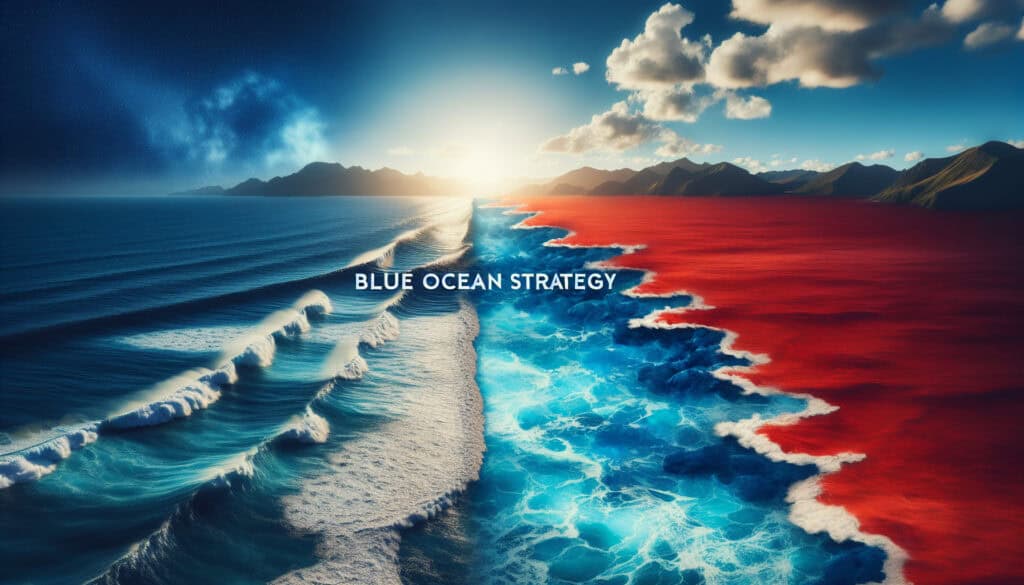A business strategy that involves creating a new market space, or ‘blue ocean’, rather than competing in an existing market, or ‘red ocean’.
- Metodologie: Ingegneria, Qualità
Strategia Oceano Blu

Strategia Oceano Blu
- Metodologia agile, Reingegnerizzazione dei processi aziendali (BPR), Analisi competitiva, Innovazione, Produzione snella, Ricerca di mercato, Sviluppo del prodotto, Differenziazione del prodotto, Proposta di valore
Obiettivo:
Come si usa:
- The goal of a blue ocean strategy is to make the competition irrelevant by creating a leap in value for both the company and its buyers.
Professionisti
- Can lead to high growth and profits, can create a strong and sustainable competitive advantage, and can be used to create new markets.
Contro
- Can be risky and difficult to execute, requires a high degree of creativity and innovation, and there is no guarantee of success.
Categorie:
- Clienti e marketing, Economia
Ideale per:
- Creating a new market space to make the competition irrelevant.
Blue Ocean Strategy has been effectively applied across various industries including technology, healthcare, and consumer goods, where organizations aim to create new market spaces by tapping into unmet needs or reimagining existing products. This methodology is particularly useful during the early phases of product development or innovation initiatives, where teams can explore unique value propositions and engage in ideation processes that prioritize customer experience and differentiated offerings. Participants in this process often include cross-functional teams comprised of marketing, design, engineering, and management professionals who collaborate to identify opportunities for innovation and value creation. In healthcare, for instance, creating a blue ocean might involve developing patient-centric solutions that integrate technology and personalized care, thus differentiating services from traditional offerings. Companies such as Cirque du Soleil exemplify successful implementation, merging entertainment with theatrical arts to create a niche market that diverges from conventional circuses. The methodology is particularly beneficial for startups and established companies alike, as it encourages a shift from competing in saturated markets to thinking creatively about how to fulfil consumer desires in novel ways. Additionally, applying this strategy can lead to a significant reduction in price competition, allowing firms to establish a clear and sustainable advantage that resonates with customers and fosters loyalty, ultimately resulting in an elevated brand perception and increased profitability.
Fasi chiave di questa metodologia
- Analyze the current market space to identify existing industry boundaries.
- Identify the factors that the industry competes on and eliminate those that do not provide value.
- Map the strategic canvas to visualize the current competitive landscape and identify gaps.
- Generate alternative value curves by exploring new ways to deliver value to customers.
- Focus on a new audience or need that has not been addressed by existing competitors.
- Develop innovative offerings that create new demand and shift buyer preferences.
- Create a business model that supports the new strategy and brings offerings to market.
- Test the new concept with target customers to refine the approach before launch.
- Implement a strategy to align the organization around the new value proposition.
- Continuously monitor and adapt the strategy based on market feedback and changing conditions.
Suggerimenti per i professionisti
- Conduct a thorough value innovation analysis to identify pain points and unmet needs in the market, which can reveal unique opportunities for differentiation.
- Utilize visual strategy tools, such as the Strategy Canvas, to map the existing industry landscape and identify where gaps exist for creating new value propositions.
- Implement iterative prototyping and testing phases to rapidly validate assumptions and refine the offering, ensuring alignment with customer expectations and market dynamics.
Leggere e confrontare diverse metodologie, raccomandiamo il
> Ampio archivio di metodologie <
insieme ad altre 400 metodologie.
I vostri commenti su questa metodologia o ulteriori informazioni sono benvenuti su sezione commenti qui sotto ↓ , così come tutte le idee o i link relativi all'ingegneria.
Contesto storico
1960
1980
1983
1990
1995
2000
2010
1950
1980
1980
1986
1994
1995
2000
(se la data non è nota o non è rilevante, ad esempio "meccanica dei fluidi", viene fornita una stima approssimativa della sua notevole comparsa)














Post correlati
Programma di produzione principale (MPS)
Personalizzazione di massa
Imbuto di marketing
Audit di marketing
Indice MAPO (Movimento e assistenza dei pazienti in ospedale)
Pianificazione delle risorse di produzione (MRP II)